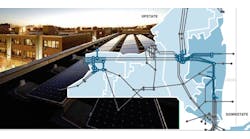University of Hawaii Maui College plans to go 100 percent green–likely a first-of-its-kind on a college campus–thanks to a solar microgrid equipped with 42 MWh of energy storage that serves five campuses.
Johnson Controls is providing the battery storage and controls and Pacific Current — a subsidiary of Hawaiian Electric Industries — will provide the financing.
“This is probably the largest behind-the-meter storage system out there,” said John Schaaf, vice president & general manager, distributed energy storage, Johnson Controls International. “It’s the largest Johnson has done.”
The financing also will allow four UH community college campuses on O’ahu to reduce their fossil fuel consumption. These include Leeward Community College, Honolulu Community College, Kapi’olani Community College and Windward Community College. The colleges expect to cut fossil fuel use 70 to 98 percent through use of energy efficiency measures, solar photovoltaics and energy storage.
Only Maui College will be 100 percent renewable, said Michael Unebasami, associate vice president for administrative affairs, UH. The college will end fossil fuel use when the solar microgrid begins operating in 2019.
Power is cheaper too
UH signed a power purchase agreement (PPA) with Pacific Current, which will own and operate the system, he said. UH will pay about 19 cents/kWh, compared to a Hawaii Electric’s cost of about 27 cents/kWh. Over 20 years, the project is expected to generate $79 million in energy savings.
The solar-plus-storage installation is the second phase of the project, which began with energy efficiency initiatives under a contract with Johnson Controls.
“The first step was to look at energy consuming systems on the campus and make them as efficient as possible,” said Schaaf. “We looked at a number of projects, like lighting and solar film on windows,” he said. This lowered baseline energy consumption enough to allow solar-plus-storage to meet 100 percent of Maui College’s needs, he said.
In Hawaii, solar producers can’t export solar to the grid. But if it were possible, the project could likely reap more savings by generating more solar and providing services to the grid, said Unebasami.
Join us in Chicago for Microgrid 2018 May 7-9. Tour microgrids, meet the players, learn from the leaders
UH could potentially cover parking lots with PV and generate more solar than what the campus can use, he said.
He noted that under the PPA, UH must take all the power that’s produced, and there are times when not all the power produced by the microgrid can be used.
“There may be times when, on weekends or when the college is not in session, the system will produce more than what batteries can hold and what the campus is using at that point in time. We would have to purchase that even if not using it,” he said.
He hopes the state of Hawaii will change the rules so that UH can take advantage of all the solar and battery capacity available.
However, the microgrid will shave the UH peak to ensure that the total call for energy generally meets the renewable energy output.
All green thanks to a solar microgrid and battery
“It’s true that electricity generated via solar can’t be exported to the grid in Hawaii,” said Schaaf. “What makes this interesting and unique is that we were able to size the solar for more than what the college will generate during the day so that we can put it into the battery to be used later in the evening or when it’s cloudy. That’s what enabled this to be 100 percent renewable.”
Smart batteries tied to smart buildings and the Johnson Controls system will allow UH to determine how much energy is used in the building and forecast how much is needed. This will allow UH to make the most of the energy storage system, he said
“The control system has the ability to forecast the dynamic load of a building going forward for the next three days,” Schaaf said.
In more and more regions, it’s now economic to use solar and storage to provide 100 percent renewable energy, he added.
“Hawaii is a leading indicator of where the rest of the country will be,” he said. Hawaii, Puerto Rico and areas with high-priced electricity will lead the way.
“As the cost of batteries continue to decline and performance continues to increase, there will be more areas of the country where this makes economic sense,” he said, noting that in some areas, storage is competitive in price with gas peaker plants.
Track news about solar microgrid projects. Follow Microgrid Knowledge on Twitter @MicrogridNews.







